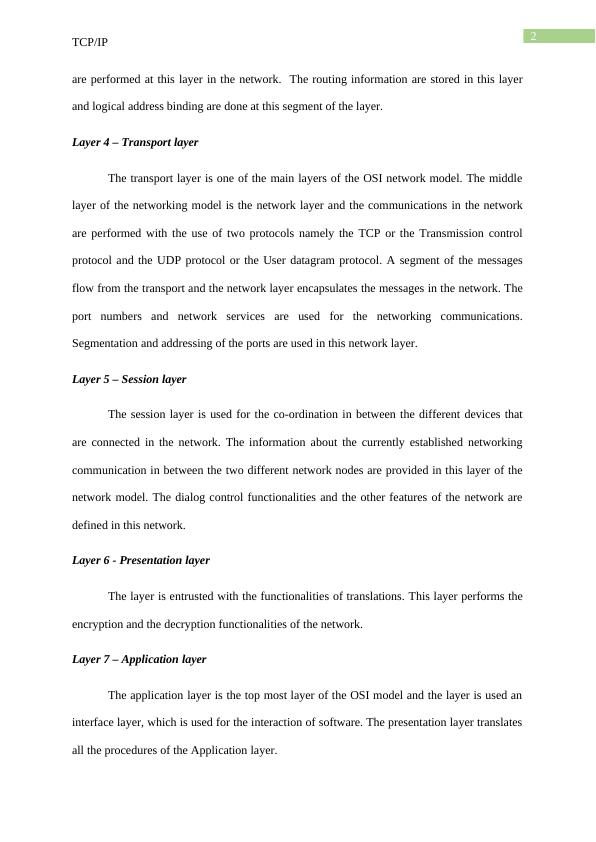TCP/IP
Added on 2023-01-19
14 Pages2571 Words62 Views
Running head: TCP/IP
TCP/IP
Name of the Student:
Name of the University:
Author Note
TCP/IP
Name of the Student:
Name of the University:
Author Note

1
TCP/IP
Answer to question number 1
The OSI model is used as a framework for the systematic and functional procedures
of the networking communication systems for different type of organization. The full form of
the OSI model is the Open system interconnection model. There are seven layers in the in
networking model and all the models interact with each other to get the communication
flowing through the network with efficiency. The description of each of the layer of the OSI
model is provided below:
Layer 1 – Physical layer
The physical layer is the bottommost layer of the model and all the connections in the
network are established with the help of this network. The layer maintains the raw bits of the
data for the communication. The layer establishes the networking by synchronizing the bits of
the components and creating the physical topologies.
Layer 2 – Data link layer
The data link layer works in the layer with the help of the physical addresses in the
devices. The data link layer is used for the establishing the connection in between two IP
addresses of the network. There are various type of protocols that are used in the networking
layer of network model. The Data link layers makes use of the MAC addresses of the source
machine and the destination machine and form a frame. The functions of framing the packets,
data control flow and this layer of the network model maintains access control within the
network.
Layer 3 – Network layer
The network layer is above the data link layer and the network layer performs the task
of forwarding of the packets. The layer is used for the data routing procedures of the network
TCP/IP
Answer to question number 1
The OSI model is used as a framework for the systematic and functional procedures
of the networking communication systems for different type of organization. The full form of
the OSI model is the Open system interconnection model. There are seven layers in the in
networking model and all the models interact with each other to get the communication
flowing through the network with efficiency. The description of each of the layer of the OSI
model is provided below:
Layer 1 – Physical layer
The physical layer is the bottommost layer of the model and all the connections in the
network are established with the help of this network. The layer maintains the raw bits of the
data for the communication. The layer establishes the networking by synchronizing the bits of
the components and creating the physical topologies.
Layer 2 – Data link layer
The data link layer works in the layer with the help of the physical addresses in the
devices. The data link layer is used for the establishing the connection in between two IP
addresses of the network. There are various type of protocols that are used in the networking
layer of network model. The Data link layers makes use of the MAC addresses of the source
machine and the destination machine and form a frame. The functions of framing the packets,
data control flow and this layer of the network model maintains access control within the
network.
Layer 3 – Network layer
The network layer is above the data link layer and the network layer performs the task
of forwarding of the packets. The layer is used for the data routing procedures of the network

2
TCP/IP
are performed at this layer in the network. The routing information are stored in this layer
and logical address binding are done at this segment of the layer.
Layer 4 – Transport layer
The transport layer is one of the main layers of the OSI network model. The middle
layer of the networking model is the network layer and the communications in the network
are performed with the use of two protocols namely the TCP or the Transmission control
protocol and the UDP protocol or the User datagram protocol. A segment of the messages
flow from the transport and the network layer encapsulates the messages in the network. The
port numbers and network services are used for the networking communications.
Segmentation and addressing of the ports are used in this network layer.
Layer 5 – Session layer
The session layer is used for the co-ordination in between the different devices that
are connected in the network. The information about the currently established networking
communication in between the two different network nodes are provided in this layer of the
network model. The dialog control functionalities and the other features of the network are
defined in this network.
Layer 6 - Presentation layer
The layer is entrusted with the functionalities of translations. This layer performs the
encryption and the decryption functionalities of the network.
Layer 7 – Application layer
The application layer is the top most layer of the OSI model and the layer is used an
interface layer, which is used for the interaction of software. The presentation layer translates
all the procedures of the Application layer.
TCP/IP
are performed at this layer in the network. The routing information are stored in this layer
and logical address binding are done at this segment of the layer.
Layer 4 – Transport layer
The transport layer is one of the main layers of the OSI network model. The middle
layer of the networking model is the network layer and the communications in the network
are performed with the use of two protocols namely the TCP or the Transmission control
protocol and the UDP protocol or the User datagram protocol. A segment of the messages
flow from the transport and the network layer encapsulates the messages in the network. The
port numbers and network services are used for the networking communications.
Segmentation and addressing of the ports are used in this network layer.
Layer 5 – Session layer
The session layer is used for the co-ordination in between the different devices that
are connected in the network. The information about the currently established networking
communication in between the two different network nodes are provided in this layer of the
network model. The dialog control functionalities and the other features of the network are
defined in this network.
Layer 6 - Presentation layer
The layer is entrusted with the functionalities of translations. This layer performs the
encryption and the decryption functionalities of the network.
Layer 7 – Application layer
The application layer is the top most layer of the OSI model and the layer is used an
interface layer, which is used for the interaction of software. The presentation layer translates
all the procedures of the Application layer.

3
TCP/IP
Layer 7 to 5 are categories under the software layer of the OSI network model. The
layers 3 to 1 are categorised under the hardware layers. The layer categorization are done
according to the functionalities performed by each of the layers.
The internet layer is categorised as the network layer of the OSI model. The network
layer handles the logical IP addresses of the devices and this layer handles the internet
connections. Hence, the name the internet layer is suggested for the layer in the networking
model. The addition to this, in a communication in between two networking nodes exchange
of data takes place, however this is possible only if the source and the destinations of the
nodes are described properly.
Answer to question number 2
Hands On project 2.3
TCP/IP
Layer 7 to 5 are categories under the software layer of the OSI network model. The
layers 3 to 1 are categorised under the hardware layers. The layer categorization are done
according to the functionalities performed by each of the layers.
The internet layer is categorised as the network layer of the OSI model. The network
layer handles the logical IP addresses of the devices and this layer handles the internet
connections. Hence, the name the internet layer is suggested for the layer in the networking
model. The addition to this, in a communication in between two networking nodes exchange
of data takes place, however this is possible only if the source and the destinations of the
nodes are described properly.
Answer to question number 2
Hands On project 2.3

End of preview
Want to access all the pages? Upload your documents or become a member.
Related Documents
Networking Technologylg...
|5
|1050
|215
OSI Model and TCP/IP Model: A Comparisonlg...
|4
|787
|271
Layers of the OSI model and TCP/IP modellg...
|5
|969
|321
TCP/IP protocol suite layer and OSI model’s layerlg...
|6
|1480
|60
Layers of OSI model and TCP/IP protocol suitelg...
|7
|1742
|74
Internet of Things (IoT) Assignment Samplelg...
|4
|789
|33
